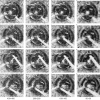Ridge operator-assisted delineation of capsulorhexis border for cataract surgery
- PMID: 37581076
- PMCID: PMC10423338
- DOI: 10.21037/qims-22-1319
Ridge operator-assisted delineation of capsulorhexis border for cataract surgery
Abstract
Background: With the continuous development of machine vision and imaging technology and its application in computer-aided diagnosis, it is clinically important to use computer technology to assist physicians in accurate cataract surgery. The capsulorhexis directly affects the outcome of cataract surgery, therefore, we design a method to automatically determine the virtual boundary of capsulorhexis for cataract surgery planning and tracking in-vivo to help surgeons achieve a more ideal capsulotomy geometry.
Methods: In this study, an effective method was proposed to detect and display the location of capsulorhexis in cataract videos in-vivo. The initial step was locating the entire eye area by analyzing the connected components of the mirror reflective points in the image in the cataract surgery video. Then, an operator was designed for ridge edge variation and used to extract pupil edge features. Lastly, circular Hough transform was used to detect the pupillary margin and calculate the boundary between the scleral limbus and the virtual capsulorhexis border in accordance with the pupillary margin and finally displayed it in-vivo during cataract surgery.
Results: The method was tested on eight videos of cataract surgery and the results showed that 98.52% accuracy was achieved in the localization of the specular reflection point. We compared the proposed operator with the Sobel, Scharr, Laplace and Canny operators and the results showed that our operator achieved the smallest mean square error with the greatest structural similarity.
Conclusions: The analysis demonstrated that the proposed operator outperformed other operators in detection and achieved satisfactory results in the videos of actual cataract surgeries.
Keywords: Continuous curvilinear capsulorhexis; cataract surgery planning; cataract video; pupillary margin; ridge edge.
2023 Quantitative Imaging in Medicine and Surgery. All rights reserved.
Conflict of interest statement
Conflicts of Interest: All authors have completed the ICMJE uniform disclosure form (available at https://qims.amegroups.com/article/view/10.21037/qims-22-1319/coif). The authors have no conflicts of interest to declare.
Figures







Similar articles
-
[Surgical treatment of hypermature cataract in patients with lens subluxation and small pupil].Vestn Oftalmol. 2021;137(5. Vyp. 2):175-180. doi: 10.17116/oftalma2021137052175. Vestn Oftalmol. 2021. PMID: 34669325 Russian.
-
Limbus-centered marking technique-assisted continuous circular capsulorhexis.Medicine (Baltimore). 2021 Jan 15;100(2):e24109. doi: 10.1097/MD.0000000000024109. Medicine (Baltimore). 2021. PMID: 33466181 Free PMC article.
-
Advances in capsulorhexis.Curr Opin Ophthalmol. 2019 Jan;30(1):19-24. doi: 10.1097/ICU.0000000000000539. Curr Opin Ophthalmol. 2019. PMID: 30394991 Review.
-
Different strokes for anterior capsulorhexis in pediatric cataract.Indian J Ophthalmol. 2023 Jun;71(6):2630. doi: 10.4103/IJO.IJO_233_23. Indian J Ophthalmol. 2023. PMID: 37322724 Free PMC article.
-
Continuous Curvilinear Capsulorhexis - A Practical Review.Semin Ophthalmol. 2022 Jul 4;37(5):583-592. doi: 10.1080/08820538.2022.2054663. Epub 2022 Apr 7. Semin Ophthalmol. 2022. PMID: 35389763 Review.
References
LinkOut - more resources
Full Text Sources
